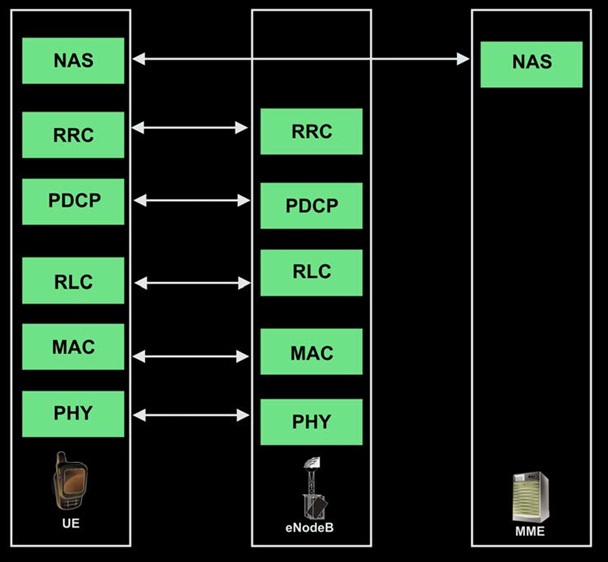The control plane includes the application protocol. It also includes the signaling bearers for transporting the application protocol messages. The application protocol is used for setting up bearers in the radio network layer. For example, radio access bearers or radio links.
Figure shows “Control plane protocol stack” comprises Radio Resource Control (RRC), Packet Data Convergence Protocol (PDCP), Radio Link Control (RLC), Medium Access Control (MAC), Physical (PHY) and Non Access Stratum (NAS) sub layers. Apart from the non access stratum (NAS) protocols, all radio interface protocols terminate in the eNodeB on the network side.
The LTE control plane protocol functions are:
LTE Physical (PHY) Sublayer:
The physical layer is between the UE and the eNodeB. The physical layer in LTE supports the Hybrid ARQ with soft combining, uplink power control, and multi-stream transmission and reception (MIMO).
LTE Media Access Control (MAC) Sublayer:
The MAC sublayer is between the UE and the eNodeB. Along with scheduling, it performs error correction through HARQ, priority handling across UEs as well as across different logical channels of a UE, traffic volume measurement reporting, and multiplexing or demultiplexing of different RLC radio bearers from the physical layer on transport channels.
LTE Radio Link Control (RLC) Sublayer:
The RLC sublayer is between the UE and the eNodeB. Along with transferring upper layer PDUs, the RLC does error correction through ARQ, in-sequence delivery of upper layer PDUs, duplicate detection, flow control and concatenation or re-assembly of packets.
LTE Packet Data Convergence Protocol (PDCP) Sublayer:
The PDCP sublayer is included in the control plane and is used for ciphering and integrity protection. In addition, PDCP sublayer is used for control plane data transmission. The PDCP receives PDCP SDUs from the RRC and forwards them to the RLC layer.
LTE Radio Resource Control (RRC) Sublayer:
The RRC sublayer is between the UE and the eNodeB. The RRC sublayer in essence performs broadcasting, paging, connection management, radio bearer control, mobility functions, UE measurement reporting and control.
LTE Non Access Stratum (NAS) Sublayer:
The NAS sublayer is between the UE and the MME. It performs authentication, security control, idle mode mobility handling, and idle mode paging origination.
Function of Control Plane Protocol Stacks in LTE
The control plane protocol stack in LTE is responsible for managing signaling and control operations between the User Equipment (UE) and the core network. It handles the setup, maintenance, and termination of communication sessions, such as authentication, mobility management, and session management, ensuring that the UE can securely and efficiently connect to the network.
The stack is composed of several layers that work together to manage network control and signaling:
- Physical Layer (PHY): In the control plane, the PHY layer is responsible for transmitting and receiving signaling messages, such as the RRC (Radio Resource Control) signaling, over the air interface.
- Medium Access Control (MAC): MAC in the control plane is responsible for scheduling control messages between the eNodeB and the UE. It also handles the multiplexing and transmission of control information like scheduling requests and uplink power control commands.
- Radio Link Control (RLC): The RLC layer in the control plane provides error correction, segmentation, and reassembly of control messages. It also handles retransmissions of lost control information to ensure reliability in the signaling process.
- Packet Data Convergence Protocol (PDCP): PDCP handles the compression and encryption of control plane messages. It ensures that signaling messages are secure by encrypting and protecting them against tampering.
- Radio Resource Control (RRC): RRC is the key control plane protocol responsible for the establishment, modification, and release of radio bearers. It also handles mobility management, including handovers, cell selection, and inter-RAT (Radio Access Technology) transitions. RRC ensures that the UE can efficiently connect, maintain, and handover between cells or networks.
These layers work together to manage network signaling and enable features like authentication, mobility, and resource allocation. The control plane ensures that communication sessions are initiated and maintained correctly, while providing the necessary support for user data transfer through the user plane.
